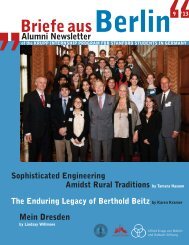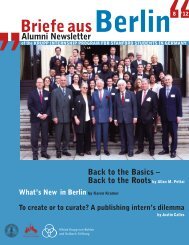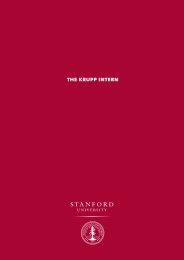Briefe aus Berlin 2009 - Krupp Internship Alumni Newsletter
Briefe aus Berlin 2009 - Krupp Internship Alumni Newsletter
Briefe aus Berlin 2009 - Krupp Internship Alumni Newsletter
You also want an ePaper? Increase the reach of your titles
YUMPU automatically turns print PDFs into web optimized ePapers that Google loves.
discover art from the Islamic world, interest in and<br />
scholarship of which is, like most genres outside of the<br />
“western canon,” still suppressed by antiquated labels<br />
such as “ethnological” and “ethnic” (I assert, perhaps<br />
naively and certainly without a CV to qualify, euphemisms<br />
and not-so-distant cousins of the words “exotic” and<br />
“primitive”). Indeed, it seems as though this has been ev -<br />
ery bit as much an opportunity to learn more about<br />
Islamic Art History and its application today as to discover<br />
my own voice in a larger discipline that is as impressionable<br />
as those who study it and live by it, in a university<br />
setting and in a museum setting. I have discovered a<br />
living, breathing, leading generation of scholars in their<br />
natural environment, and not only get to study their work<br />
while they do it but also question it and learn from it.<br />
The reopening of the newly renovated Neues Museum<br />
is an indication of Germany’s efforts both to refurbish its<br />
topography and to continue to revitalize its commitment<br />
to supporting and promoting cultural heritage. Indeed,<br />
October 16, the day the Neues Museum officially reopened<br />
to the public, marks the first time since before the<br />
war that all the museums on the island are available to<br />
Back view of the Neues<br />
Museum with roof of the<br />
Altes Museum.<br />
visitors simultaneously. But this historic moment exemplifies<br />
a much larger, ideological change on Museumsinsel,<br />
change which is not so much a restoration of a pre-<br />
War legacy as a new interpretation of the museum’s role<br />
in contemporary society. While the construction on what<br />
I like to call the Procession Arcade of <strong>Berlin</strong> – it is quite<br />
this grand – or as the master plan calls it, the James<br />
Simon Galerie, is well underway, we in the Museum for<br />
Islamic Art are planning the big move, which entails not<br />
only the final, entire unification of the former East and<br />
19<br />
A <strong>Berlin</strong> highlight in<br />
autumn <strong>2009</strong> was the<br />
reopening of the<br />
Neues Museum with<br />
three collections: the<br />
Antikensammlung,<br />
the Ägyptisches Museum<br />
(Nofretete is<br />
back!) and the Museum<br />
für Vor- und<br />
Frühgeschichte. The<br />
neoclassical building<br />
was erected with<br />
http://www.wiederaufbauneuesmuseumberlin.de<br />
innovative industrial<br />
technologies between<br />
1843 und 1855<br />
according to plans by<br />
Friedrich August<br />
Stüler. It was<br />
destroyed in WWII<br />
and is the last building<br />
to be reopened<br />
on the Museumsinsel,<br />
which is registered as<br />
part of UNESCO’s<br />
World Cultural Heri-<br />
tage. The interior has<br />
been partly preserved<br />
and partly redesigned<br />
by the architect David<br />
Chipperfield. The<br />
gable inscription is<br />
ARTEM NON ODIT<br />
NISI IGNARUS –<br />
Nur der Unwissende<br />
verachtet die Kunst,<br />
or: Only the ignorant<br />
show contempt for<br />
art.<br />
West’s collections and a change of location of the Museum<br />
within the Pergamon, but also a redesign of how<br />
we present our collection in an attempt to make it most<br />
meaningful for our guests. What information about its<br />
objects is the museum responsible to give? What information<br />
do the visitors want? Again, the museum becomes<br />
a medium itself to convey meaning about its collection<br />
as opposed to just a container or depository.<br />
While questions of how much text (and in which languages)<br />
one should put into the exhibition next to the<br />
display are not necessarily unique to the Museum for Islamic<br />
Art and most certainly not novel in the museum<br />
world, we are also making considerations in planning for<br />
the new design of the museum which, if put into action,<br />
would place Islamic Art, literally and symbolically, on the<br />
same level of those “old masters” from prehistory to postmodern.<br />
In accordance with this new method of presenting<br />
Museumsinsel’s remarkable collection, Islamic Art<br />
will be placed in direct dialogue with its inherited past in<br />
the Pergamonmuseum: starting in Pharaonic Egypt, proceeding<br />
to the Ancient Near East and then onto Greece<br />
and Rome, one finally walks into the Islamic world, the<br />
Museum for Islamic Art. Even more ground breaking is<br />
the concept of the “Promenade,” which will very much<br />
be a walk through the nonlinear, thematic history of the<br />
human condition (and through all of the museums, too!),<br />
on which visitors can explore history and culture through<br />
an art historical context: Art of Memory – Memory








